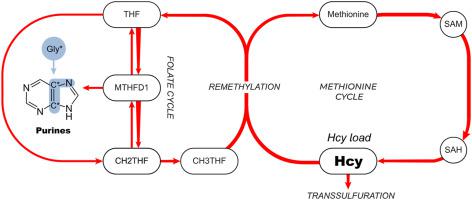当前位置:
X-MOL 学术
›
Int. J. Mass Spectrom.
›
论文详情
Our official English website, www.x-mol.net, welcomes your
feedback! (Note: you will need to create a separate account there.)
A Low-Cost Mass Spectrometry-Based Approach for Quantifying Purines in Placental Explants
International Journal of Mass Spectrometry ( IF 1.6 ) Pub Date : 2021-02-01 , DOI: 10.1016/j.ijms.2020.116490 Ruslan Rodriguez , Igor Konovets , Serhii Ralchenko , Maxsim Kharkhota , Andrij Kostyuk , Victoriia Kosach , Irina Voronina , Natalia Filimonova , Maria Obolenskaya
International Journal of Mass Spectrometry ( IF 1.6 ) Pub Date : 2021-02-01 , DOI: 10.1016/j.ijms.2020.116490 Ruslan Rodriguez , Igor Konovets , Serhii Ralchenko , Maxsim Kharkhota , Andrij Kostyuk , Victoriia Kosach , Irina Voronina , Natalia Filimonova , Maria Obolenskaya

|
Abstract Purine nucleotides serve as immediate building blocks for the synthesis of RNAs and DNA, energy carriers and co-substrates in the activation of many metabolites, regulators in cellular metabolism, and signaling molecules. Knowledge of the actual tissue-specific concentration of these metabolites and their synthesis rate is essential to studies focused on a tissue-specific metabolic rewiring in the pathogenesis of different diseases, including carcinogenesis. The existing data mainly characterize the purine concentration in body fluids and malignant cells. The protocols for estimating de novo purine biosynthesis usually required the usage of radioactive precursors and costly facilities like HPLC with tandem mass spectrometry or nuclear magnetic resonance. We developed a new simplified method to measure the level of purines by HPLC/ESI-MS, using a stable isotope glycine to label and measure newly synthesized purines. The developed method proved to be highly sensitive, interday repeatable, and intraday reproducible. We applied the method to measure purine concentration and the rate of purine synthesis in placental explants from the first and third trimesters of gestation and MCF7 cells cultivated with 20 μM and 40 μM homocysteine. Corresponding homocysteine concentration is typical for breast cancer and pregnancy-associated complications affecting the human placenta. The content of total purines in placental explants from the first trimester of gestation was around 9.0 μmol/g wet tissues at specified cultivation conditions. The newly formed purines comprised approximately 1 % of total purines and decreased steadily in explants cultivated with 20 mM and 40 μM homocysteine. They reached the values characteristic for explants from the third trimester grown without homocysteine, 4.0 μmol/g wet tissues. In MCF7 cells, the newly formed purines comprised around 50 % of total purines and decreased under homocysteine treatment. A low-cost mass spectrometry-based approach may be used to estimate the level and the rate of purine synthesis in eukaryotes' tissues in a wide range of purines concentrations.
中文翻译:

一种基于质谱的低成本方法定量胎盘外植体中的嘌呤
摘要 嘌呤核苷酸是 RNA 和 DNA 合成的直接组成部分、能量载体和激活许多代谢物的共底物、细胞代谢的调节剂和信号分子。了解这些代谢物的实际组织特异性浓度及其合成速率对于专注于不同疾病(包括癌变)发病机制中的组织特异性代谢重组的研究至关重要。现有数据主要表征体液和恶性细胞中的嘌呤浓度。估计从头嘌呤生物合成的协议通常需要使用放射性前体和昂贵的设施,如具有串联质谱或核磁共振的 HPLC。我们开发了一种新的简化方法,通过 HPLC/ESI-MS 测量嘌呤水平,使用稳定同位素甘氨酸标记和测量新合成的嘌呤。所开发的方法被证明是高度灵敏的、日间可重复的和日内可重复的。我们应用该方法来测量来自妊娠早期和晚期的胎盘外植体以及用 20 μM 和 40 μM 同型半胱氨酸培养的 MCF7 细胞中的嘌呤浓度和嘌呤合成速率。相应的同型半胱氨酸浓度对于影响人类胎盘的乳腺癌和妊娠相关并发症是典型的。在特定的培养条件下,妊娠前三个月的胎盘外植体中总嘌呤含量约为 9.0 μmol/g 湿组织。新形成的嘌呤约占总嘌呤的 1%,并且在用 20 mM 和 40 μM 同型半胱氨酸培养的外植体中稳步下降。他们达到了在没有同型半胱氨酸的情况下生长的孕晚期外植体的特征值,4.0 μmol/g 湿组织。在 MCF7 细胞中,新形成的嘌呤约占总嘌呤的 50%,并在同型半胱氨酸处理下减少。一种低成本的基于质谱的方法可用于估计各种嘌呤浓度的真核生物组织中嘌呤合成的水平和速率。
更新日期:2021-02-01
中文翻译:

一种基于质谱的低成本方法定量胎盘外植体中的嘌呤
摘要 嘌呤核苷酸是 RNA 和 DNA 合成的直接组成部分、能量载体和激活许多代谢物的共底物、细胞代谢的调节剂和信号分子。了解这些代谢物的实际组织特异性浓度及其合成速率对于专注于不同疾病(包括癌变)发病机制中的组织特异性代谢重组的研究至关重要。现有数据主要表征体液和恶性细胞中的嘌呤浓度。估计从头嘌呤生物合成的协议通常需要使用放射性前体和昂贵的设施,如具有串联质谱或核磁共振的 HPLC。我们开发了一种新的简化方法,通过 HPLC/ESI-MS 测量嘌呤水平,使用稳定同位素甘氨酸标记和测量新合成的嘌呤。所开发的方法被证明是高度灵敏的、日间可重复的和日内可重复的。我们应用该方法来测量来自妊娠早期和晚期的胎盘外植体以及用 20 μM 和 40 μM 同型半胱氨酸培养的 MCF7 细胞中的嘌呤浓度和嘌呤合成速率。相应的同型半胱氨酸浓度对于影响人类胎盘的乳腺癌和妊娠相关并发症是典型的。在特定的培养条件下,妊娠前三个月的胎盘外植体中总嘌呤含量约为 9.0 μmol/g 湿组织。新形成的嘌呤约占总嘌呤的 1%,并且在用 20 mM 和 40 μM 同型半胱氨酸培养的外植体中稳步下降。他们达到了在没有同型半胱氨酸的情况下生长的孕晚期外植体的特征值,4.0 μmol/g 湿组织。在 MCF7 细胞中,新形成的嘌呤约占总嘌呤的 50%,并在同型半胱氨酸处理下减少。一种低成本的基于质谱的方法可用于估计各种嘌呤浓度的真核生物组织中嘌呤合成的水平和速率。











































 京公网安备 11010802027423号
京公网安备 11010802027423号